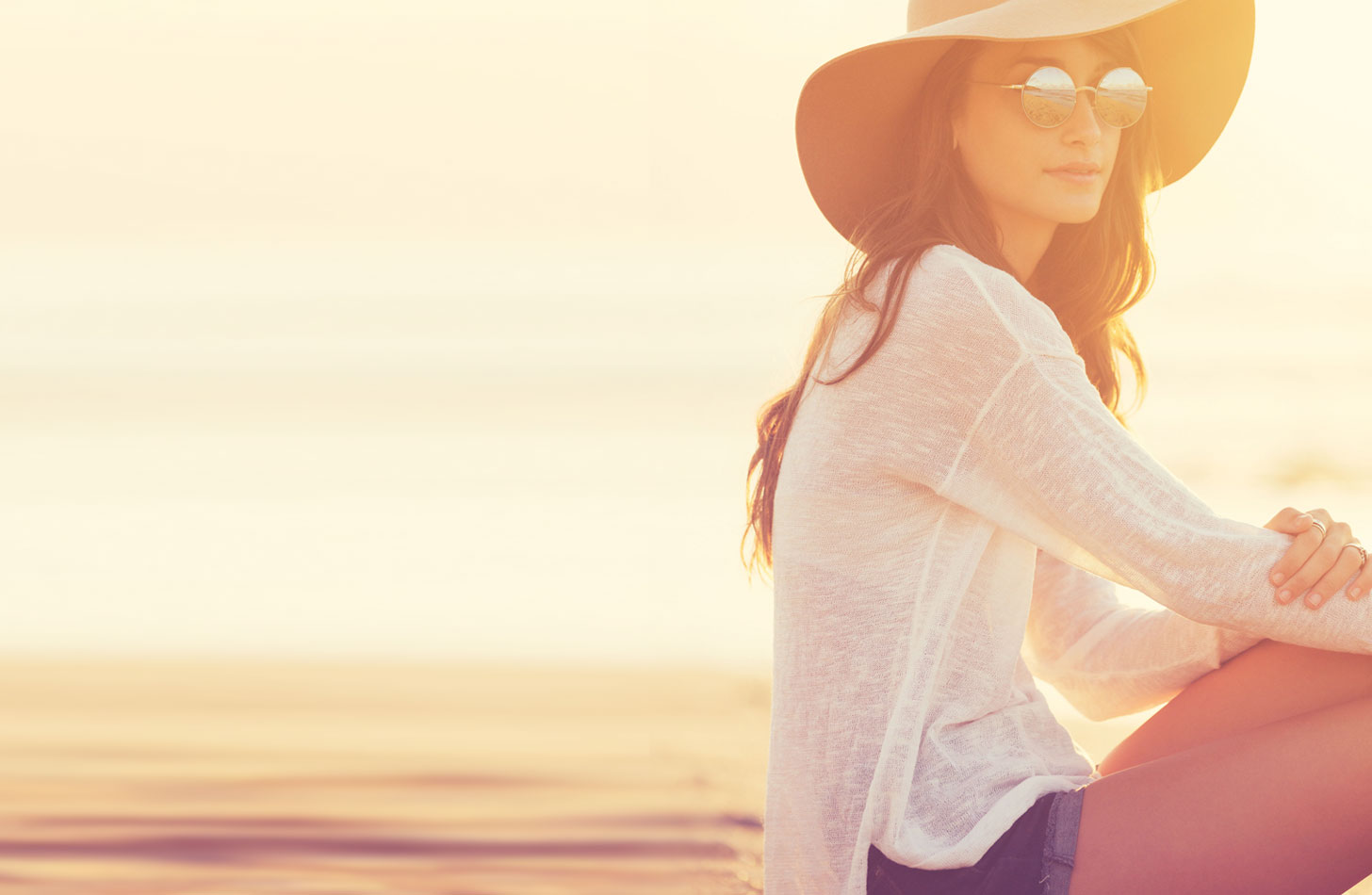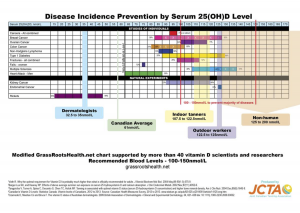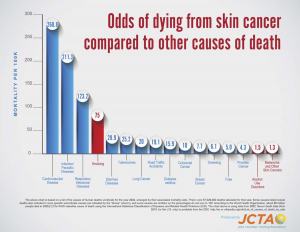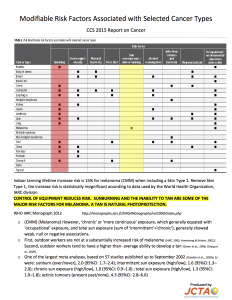“Are there any benefits of UV light?”
There are many benefits to UV light exposure. Most people know about the sunshine vitamin, vitamin D. This is the only vitamin that your body produces naturally when UVB light hits your skin. But there is also new research showing UVA light helps produce nitric oxide, which lowers blood pressure to help reduce cardiovascular disease risk. There is also photoprotection you get from a tan – equivalent to about an SPF 6 chemical sunscreen. Did you know a tan is a multiplier for when you use a sunscreen? Humasn would not survive without sunlight. There are so many photoproducts being produced from sunlight, so abstinence is not the way to think. A group called Grassrootshealth.net, which was started by a breast cancer survivor, created a chart for disease prevention. Our association did some overlays based on research to show you how UV light can help.
Remember, everything in moderation. Most risks that we encounter are about overexposure. Food, water and sunlight can all be risky when you overdo it.
“What’s my risk of skin cancer?”
This is a great question, and there have been so many stories written about sunlight/sunbeds and the risk. Because of this, our association put together a few charts to explain the risk compared to other risks, much like what the airline industry did a few years back when everyone was afraid to fly. The first chart is a comparison of risks you have in your daily lives. The majority of the data in the chart comes from the World Health Organization (WHO). The skin cancer numbers you see on the chart are for all skin cancers, no matter what the cause was. The WHO does not report mortality numbers for the risk for sunbed or sunlight alone. One report out of the UK said approximately 7% of melanoma could be caused by sunbeds, and the risk of dying from melanoma if you had melanoma is less than 1 in 10 if diagnosed early. When talking about research and data, you have to realize what’s included in the numbers; commercial, home and medical sunbeds. Commercially controlled equipment carries nearly zero increased risk when you remove Skin Type 1 persons (always burns, never tans) from the equation. All professional salons ban these people from indoor tanning.
Some people think sunbathing and smoking have the same comparable risk. As you can see in the chart above, the risks are not remotely similar.
This second chart, which was produced by the Canadian Cancer Society in 2015 also shows sunlight/sunbed and smoking carry a small fraction of the risk. The risk is small in comparison to alcohol also, when you look at all the increased risks you have compared to sunlight or sunbeds.
Risk will always be about who controls the equipment. This is why you need to find a salon that has an industry certified operator. For more information check out TanResponsibly.ca.
“What is a base tan?”
Thanks for the question. A Base Tan is protection from overexposure. This is created by either natural sunlight or a sunbed. UVB rays from sunlight or sunbed hit the melanocytes which are in the first layer (epidermis) of your skin at the bottom. The melanocytes start making melanin, which surrounds your DNA to protect from overexposure. Then UVA and oxygen turn the melanin brown. At the same time, the outer dead skin layer starts to thicken. The reason we call this a base tan when using a sunbed is it’s the starting point of your tan. If you go to a tropical place your tan can get darker because of the higher UV coming from the sun and time spent outside.
Remember when building a tan you need to do it slowly and increase the amount of exposure slowly. Don’t think you’ll get a tan in a few sessions: This takes time. Normally it take 3 to 4 sessions to start seeing results. Remember the Golden Rule of Tanning: Never burn. If you are a Skin Type 1 person, which means you “always burn and never tan” you should not use a sunbed and minimize any exposure outside.
For more information or knowing your skin type, please visit TanResponsibly.ca
“Are tanning beds the same as the natural sun?”
Thanks for your question. According to a European Commission report; There is no difference in the biological (and general health) effects induced by UV radiation in respect to their origin, the natural solar UV or artificial UV from e.g. tanning devices. The difference is the intensity coming from the source. Solar UV changes (mix of UVA and UVB and intensity) based on the time of day, distance from the equator, time of year, cloud cover, altitude. A 20-minute sunbed session that has a UV output that mimics sunlight is equal to 58 minutes on a sunny day in in July with the UV index at 8 in Canada, according to Health Canada.
A sunny day at noon in July has about 5% UVB and 95% UVA mix. Sunlight spectrum is made up of about 5% UV that hits the earth. The majority of lamps for sunbeds today mimic sunlight, except the intensity. UVB is less intense, and in a fluorescent lamp, the intensity is 2 to 3 times stronger for UVA. A high pressure lamp has almost pure UVA and can be 5 to 10 that of sunlight. This is why sunbed session times are so low.
The big difference in exposure is a sunbed is constant, and if you use a professional salon, they have trained and certified operators controlling the equipment. To find a professional salon go to www.TanResponibly.ca
“Best product for a dark tan”
Thanks for your question, check out the question – What kind of lotion is better to get a dark tan?
“What is UVA?”
Thanks for your question. UVA stands for Ultra Violet A Rays. UVA is just below visible light spectrum at 320 to 400nm wavelength. UVA is a relatively long wavelength and accounts for approximately 95 per cent of the UV radiation reaching the Earth’s surface. It can penetrate into the deeper layers of the skin and is responsible for the immediate tanning effect.
UVB is required for the production of melanin from the melanocytes in your first layer of skin, this is what starts your photoprotection or tan.
“What kind of lotion is better to get a dark tan?”
Great question, thanks for asking. Everyone’s skin is different, and that’s why there are so many different products out there. The most important thing I’ve learned over the years is the product must have great hydrating properties and be specifically formulated for tanning. The reason for great hydrating ingredients is dry skin reflects light because it’s curved outward. The flatter the skin, the more UV light is allowed to pass through.
The next step is the micro-nutrients required by the cells that produce your pigmentation (melanocytes). No food for the cells = no great tan! This is the most important reason to purchase a professional indoor product specifically formulated for tanning. It helps you enhance your tan and protect your skin.
The next ingredient is what helps you stimulate increase blood flow; we need oxygen to tan. These ingredients have come a very long way since their inception. More oxygen to the surface of the skin, the better our tan. The melanocyte produces melanin (skin pigmentation) to surround your skin cell and protect from overexposure. UVA light and oxygen turn the pinkie melanin to brown as it puffs up over the skin cells.
To get that instant start on your tan, lotions use bronzer and ingredients that attach to your skin to turn you brown. There are several types of bronzers, however the two most common types are instant and delayed bronzers. Instant bronzers sit topically on the skin to give instant gratification and will wash away in your shower. Of the professional delayed bronzers, DHA is the most common. It is a protein that attaches to your skin cells and oxidizes over time to turn you brown. Delayed bronzers paired with a professional body wash and tan extender can last up to 7 days or more!
I would suggest you contact your local JCTA Professional Salon at http://www.tanresponsibly.ca/ for further information on personalizing the right product for your skin.
“How long should I tan for outside?”
Thanks for your question. This depends on a number of factors; your Skin Type, the UV Index, your age, whether you have pre-tanned indoors, cloud cover and altitude. So lets look at each one:
Skin Type: You need to know your individual skin type — check out www.SkinType.ca. If you are a Skin Type 1, don’t try and get a tan. You’ll normally overexpose yourself, which is not good for you at all. Skin Type 2 to 6, you can achieve a tan, but the lower the number, the higher the risk of overexposure. Everyone need to acclimatize there skin, by slowly increasing their exposure. Don’t rush it; it will take time for you to see the tan come out. When indoor tanning, it normally takes 3 to 4 sessions before you start to see you tan.
Age: As we get older, it takes longer to get a tan, based on your Skin Type.
UV Index: The higher the UV index, the faster you will tan. This may sound great, but you want to start with a lower UV index like you would see in the Spring in Canada. This way you are acclimatizing your skin.
Pre-tanned skin with indoor tanning: This is why most people indoor tan; it’s a controlled environment with a trained and certified operator controlling the exposure of the equipment. This acclimatizes your skin for higher UV Index exposure, which also allows you to stay out longer without sunburning. Sunburning should be avoided at all cost.
Cloud Cover: This blocks UVB light from hitting the earth and slows the tanning process. You need UVB light to produce melanin (pigmentation) in your skin. You could say it reduces the UV Index.
Altitude: The higher you are, the more intense the UV light. So check the UV index before tanning outdoors.
With all these factors in mind, remember to go slowly and build your tan over time. There is a myth out there that “I need to burn to get a tan.” This is absolutely false. You actually stop the tanning process until you skin has repaired the burn. If you’re tanning correctly, you may see some slight pinkness on the surface of your skin before your pigment oxidizes and turns brown.
Please Tan Responsibly!
“What is a Skin Type?”
A Skin Type is a rating of your sensitivity to sunlight. First designed by Dr. Fitzpatrick for phototherapy, the indoor sunbathing industry worked with Dr. Fitzpatrick to design a modified version for UV tanning. The lower your Skin Type number the more sensitive you are to UV light. For example, a Skin Type I person always burns and never gets a tan; this is why professional salons do not allow these people to tan indoors. A Skin Type I person should avoid sunlight as much as possible and not try to get a tan. If you’d like to know your Skin Type, go to TanResponsibly.ca. Knowing your Skin Type is very important if you decide to tan; all sunbeds are designed with an exposure schedule based on Skin Type so you don’t sunburn.
“I have an unlimited tanning package. Why can’t I tan as many times as I want? Twice in one Day?”
There is no such thing as an unlimited tanning package. The word “Unlimited” is just a marketing term for a monthly package. Based on Health Canada’s regulations on the manufacturing and importation of equipment, there is a maximum exposure time per day. This is based on a calculation to reduce the risk of overexposure to a consumer. This is also based on the client’s Skin Type. You should always follow the amount of time the manufacturer recommends between sessions. Most recommend 3 times a week when building a tan and 1 to 3 times a week to maintain a tan. No manufacturer recommends tanning more than once a day.
The JCTA recommends tanning every second day at a maximum. This way, if you accidentally overdid it on a session, your skin has time to repair. Remember the key is moderation. Follow the JCTA Professional Standard, and make sure the person controlling the equipment is industry certified and trained. For further information on what a professional salons follows for standards go to www.TanResponsibly.ca
“Can I tan when pregnant?”
First talk with your doctor about indoor tanning when pregnant. Every salon will have a policy on whether a pregnant woman can tan or not. Check with your salon to see what their policy is. These policies can be based on what their insurance company requires.
Here is what we know: You can tan, but you need to be very careful about heat and pressure from the baby on your spine, if tanning in a sunbed. We suggest you tan in the morning when the equipment is cooler or make sure the equipment hasn’t been used for some time. As for pressure on the spine from the weight of the fetus, either lay on your side in a sunbed or use a standup unit, especially in the 3rd trimester. Research has shown that you need more vitamin D when pregnant. The natural way to make vitamin D is from UVB light, which comes from a sunbed or sunlight. Just make sure the equipment you are tanning under has UVB – it’s been estimated that over 90% of equipment in Canada has some portion of UVB light. Remember, you don’t need to get a tan to make vitamin D. Dr. Michael Holick (world’s foremost vitamin D researcher) said all you need is a 1/3 to 1/2 a session to make you’re vitamin D in a sunbed. Please make sure you have an industry certified and trained operator looking after you, if you decide to tan.
“Why can’t I chose my own session time? I have this young girl trying to tell me what to do. I’ve been tanning for years at another salon and they let me do what I want.”
Session times are very specific to the equipment you’re tanning in. If you’re now tanning at a JCTA member salon, all operators are industry certified and trained. What most people don’t understand is it takes 3 to 4 session before you start to see a tan on your skin. A professional salon will make sure you are skin typed correctly and they use the correct exposure schedule for that specific piece of equipment. The session times are based on making sure you don’t overexpose yourself. There are built-in safe guards to make sure you don’t sunburn. Let the trained technician take care of you; they know their equipment.
“Can I spray tan when breastfeeding?”
I suggest you consult your doctor first before spray tanning. I’ve not seen any research that says you should not spray tan when breastfeeding. I do recommend that you use a bikini when spray tanning as a precaution. This will cover the nipple area so no solution is accidently ingested by the baby. Also use nose/ear guard that are recommended by the equipment manufacturer. Keep your mouth closed and use a lip balm on your lips. These would be the same precautions you would want to take if using a sunscreen.



